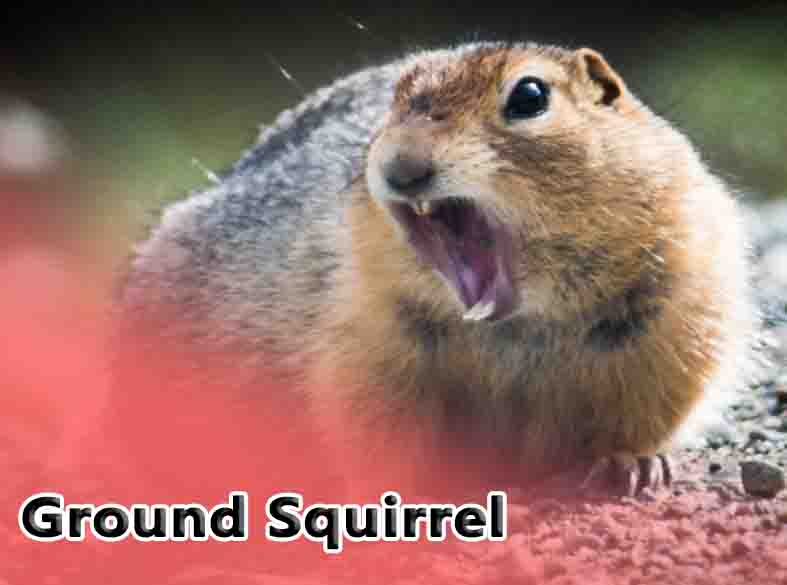The Basics
Among the more than 24 genera of ground squirrels (Sciuridae), the ground squirrel is a rodent family. This typically refers to medium-sized species such as California ground squirrels (Otospermophilus beecheyi), but also includes larger species like marmots and smaller species like chipmunks.
It is common knowledge that ground squirrels, also known as groundhogs or gophers, stand tall on their hind legs to detect potential predators.
The size of ground squirrels varies greatly among the various genera and species. Marmots weigh up to 18 pounds (8 kilograms), making them the heaviest squirrels. A chipmunk, on the other hand, weighs as little as 50 grams (0.1 lb). Their bodies are long, slender, and their legs are short. Its claws are relatively long and strong, allowing it to dig and, in some cases, climb.
There are a variety of colors that range from dark reddish browns to grays and olives. Some species have patterns on their fur, such as stripes on chipmunks or lines of spots on rabbits. The undersides of their bodies are often lighter, often white or a lighter gray or brown color.
Ecology and Behavior
As their name suggests, most ground squirrels live on the ground, often burrowing underneath it. They tend to inhabit open fields or pastures, and for this reason, have become known as pests for livestock in areas developed by humans.
Ground squirrels can be found from sea level to very high altitudes, such as the Barbary ground squirrel (Atlantoxerus getelus) which lives in rocky habitats up to 13 000 ft (4 000 m).
Ground squirrels are omnivores and eat a variety of items found in their grassy environments. This may include various mushrooms and other fungi as well as nuts, fruits and seeds. On occasion, they will also eat the eggs of birds or snakes as well as insects and other small animals.
Some species have cheek pouches they use to transport food to their young or to store food in their burrows for later.
Mating habits vary among species, but most ground squirrels are communal, with a strong social bond between mother and young. During mating season, which is typically in spring, males will become aggressive with other males in their competition for mates. Following copulation, often with multiple males, females give birth to about 5-10 young following a gestation period of 3-4 weeks.
These hairless pups are as small as 0.35 oz (10 g) when born but are weaned just six weeks later, at which point they will grow very quickly before the following winter, especially in hibernating species.
Fun Facts about Ground Squirrel!
Ground squirrels, commonly called gophers, have a lot in common with the arboreal cousins from food caching to hibernating in colder climes.
Storage Pouch
Some species, such as those of the genus Xerus that live in savannas and deserts in Africa as well as hibernating species are known to have storage pouches in their cheeks. They use these to transport food to caches, typically in their burrows.
Here, they can access the food later or share it with a mate or their offspring. In the tropics, where species are active year round and food availability is not highly seasonal, ground squirrels don’t resort to food storage to remain satiated.
Around a While
The earliest fossil of the ground squirrel lineage dates back as far as 30 million years ago. This genus is known as Palaeocsciurus and likely persisted until 15 million years ago.
Although related, this genus was quite different from many modern-day ground squirrels, but likely diverged from the the 3 extant genera of Marmotini long ago. Other parts of the ground squirrel family fossil record is incomplete.
A Deep Sleep
Some ground squirrel species – particularly those that live at higher latitudes and in colder climates – will hibernate during the winter. Deep in their underground burrow, species such as the 13-lined ground squirrel (Spermophilus tridecemlineatus) and other members of the genera will drop their body temperature from 98.6 °F (37 °C) to as low as 1 degree above the temperature of their burrow.
Their heart will beat very slowly during this time, decreasing to about 5 beats per minute (bpm) from their typical 200-250 bpm. They will also respire (breath) very slowly, taking just 4 breaths per minute.
This hibernation allows them to conserve their body’s energy stores throughout the winter when food supply is scarce. By going into an energy-efficient state, their chances of surviving the winter greatly increases.
With enough preparation putting on fat during the summer months, these ground squirrels will be around to enjoy the following summer’s bonanza as well.
The Siesta Strategy
While some ground squirrels hibernate during the winter months, other species remain active all year. The African ground squirrel, for example, does not have to utilize hibernation to make it through the winter. Instead, it has the opposite problem: too much heat and sun.
All ground squirrels burrow, and in this case, their burrow provides the solution as well. Ground squirrels in these warmer climates will use their burrows as shade, allowing them to regulate their body temperature by entering and exiting their burrow as needed and according to the weather and time of day.
Just like many humans that live in tropical climes, they tend to be less active during the middle of the day when it is hottest.

